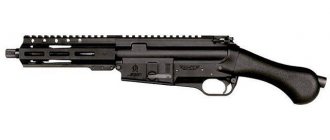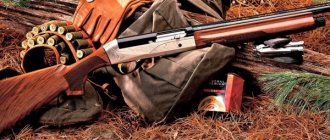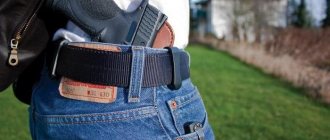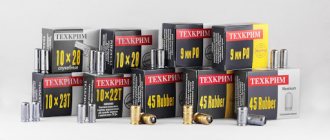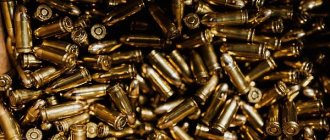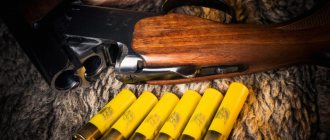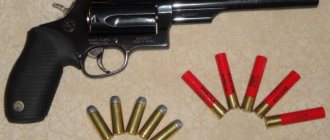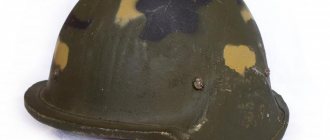As an example, we use the Rock Chucker Supreme Master Reloading Kit with a single-stage press.
This kit has everything you need to start loading ammo like a pro. It is a simple, complete solution for both beginners and experts. All that is additionally required from you is dies, bullets, primers, cartridges, gunpowder and shellholders.
Set Contents
Mechanical scales M500
They allow you to carry out weighing with both left and right hands. Considering their cost, they are surprising in their convenience. This scale is accurate, fast and durable - just what a scale should be for easy reloading.
Nosler Ammo Loading Guide
A comprehensive, nationally recognized step-by-step guide covering everything you ever wanted to know about handloading ammo with 600 pages of helpful facts, illustrations and data.
Handle-2
Ergonomic handle suitable for many RCBS accessories
Hex key set
Contains 8 hardened hex keys in one compact set. These wrenches will fit almost any screw in RCBS products
Chamfering tool .17 - .60
This large tool will allow you to remove internal and external chamfers and remove burrs from 17- to 60-gauge cases. One tool for all these tasks at once.
Powder funnel
Such a funnel is useful for pouring an exact portion of the powder charge into the cartridge case. It is specially designed to avoid spillage of the mixture near the cartridge case mouth.
Sleeve lubrication and preparation kit
The first step when handloading a cartridge is to thoroughly clean and lubricate the spent cartridge case. This kit contains a bottle of Case Lube - 2, a mat and two brushes.
Manual encapsulator
It will help you get things done away from the workbench. The container can hold up to 100 capsules. Uses the same RCBS shelholders as stationary presses from the same company.
Universal stand for cartridge cases
Convenient double-sided stand for cartridges with seating for 3 different sizes of cartridges on each side. Perfect for holding up to 50 shells while loading cartridges.
Rock Chucker Supreme Single Stage Press
This is definitely the largest tool in the entire set. Below you will see that the press is needed to calibrate the case, remove used primers and seat the bullet with a crimp.
Uniflow powder dispenser
This dispenser will significantly speed up the reloading process. A predetermined portion of the mixture pours out of this device with each turn of the handle. This eliminates the need to weigh each portion of the substance.
Why load your own ammunition?
Not all novice hunters fully understand why people resort to using “roll-your-own” cigarettes. This is understandable - after all, in modern gun stores you can find a huge variety of ammunition for every taste and budget. Here you can find inexpensive but reliable Russian cartridges, high-precision American, and even budget Turkish shells. However, over all of them, “roll-your-own” cigarettes have a number of undeniable advantages:
- Economic benefit. If you buy all the main parts of the cartridge separately (case, primer, gunpowder, bullet, etc.), then the cost of the ammunition is much cheaper. Of course, the difference will be small if you compare a “homemade” projectile with what is produced at the Barnaul or Tula cartridge plant. However, if you place an American projectile nearby, which costs several hundred rubles apiece, the savings will become obvious.
- Optimal indicators of powder mass and projectile mass. Considering that during reloading the hunter himself chooses which attachment to use, the final product is much more suitable for specific purposes. For example, there is no point in loading a cartridge with a large amount of powder and a heavy projectile if it is to be used for long-range shooting practice. But for hunting from a distance of 300 meters or more, the weight can be increased.
- Confidence in quality. Yes, many of you have heard stories of other hunters having their chambers or barrels blown out after using home-loaded ammunition. However, let's be honest - the hunter is responsible for the quality of the cartridge made with his own hands. So if the shooter did everything correctly and according to the instructions, then he will have much more confidence in the quality of the “homemade” projectile than the factory one.
Loading rifled cartridges serves the same purpose as with smoothbore ammunition. Those who have at least once reloaded a shell for a gun or a shotgun at home will be sure of this. As for the supporters of purchased shells, they can also be understood, because in addition to theoretical knowledge, the hunter will also need some equipment. However, it would be wrong to dismiss all the positive qualities of “rolled cigarettes” because of this.
Sequence of steps
Follow this step-by-step guide with the tools in the Rock Chucker Supreme Master Reloading Kit and you'll soon be loading ammo like a pro.
Cleaning and checking
Using a soft towel, napkin or rag, clean each cartridge from dirt. This will protect it and the molding matrix from scratches. Carefully examine the sleeve for damage to the outer surface. If any defect is found, such as shell cracks, dents or breaks, do not use the cartridge case as this may be dangerous. Any unsuitable cartridge case should be disposed of.
Lubricating the Case (Part 1)
Due to the large forces exerted during molding with a matrix, the sleeve must be pre-lubricated. Apply lubricant to the mat; roll the sleeves over it to lubricate their outer surface. Do not apply force and do not lubricate the cartridge case as... this may cause dents. If you are working with a carbide die to form straight wall pistol cases, you can skip this step: The carbide ring in the die glides perfectly and does not allow the case to get stuck during molding.
Lubricating the Case (Part 2)
Remove dirt and remaining powder mixture from the inside of the case and at the same time apply a thin layer of lubricant using special brushes from the kit. This will reduce the force required for molding and protect the material from unnecessary mechanical stress. Roll the brush over the mat after working three or four sleeves to apply the correct amount of lubricant.
Shellholder installation
Insert the Shell Holder into the press bases with a slight twisting motion. The shellholder is needed to hold the case in place during molding. Check out our latest catalog or contact your local dealer for assistance in selecting a shellholder. This information can also be found on pages 12-13 of the handbook.
Installation of the forming (crimping) matrix
Screw the crimp die into the top of the press until it contacts the shellholder in the lower position of the lever. After this, move the press to the upper position and lower the die another eighth or quarter of a turn and use the locking ring. If you are using a carbide die, leave a gap of one and a half millimeters between the tip and the shellholder.
Installing the sleeve
Move the lever up, insert the sleeve into the shellholder.
Case molding
Gently but forcefully lower the press lever down, driving the sleeve inside the matrix to its full depth. This will give the case the shape it needs for the cartridge and remove any used primer. After this, lift the handle of the press. This will expand the muzzle of the cylindrical cartridge case, preparing it for a tight fit of the bullet when the cartridge is further loaded.
Checking the length of the sleeve and trimming if necessary
After repeated use, cases may stretch and become longer than the specified maximum length. These cartridges must be trimmed for proper and safe loading. The trimmer resembles a miniature lathe and is suitable for trimming most cases up to .45 caliber. Refer to the book included in the kit for sleeve and trim lengths. Use a digital or traditional caliper to accurately measure case length.
Chamfering and deburring
Trimmed sleeves need to be deburred and chamfered. This will remove unnecessary irregularities on the side of the case muzzle and ensure easy seating of the bullet. Insert the sharp tip of a special cutter into the sleeve and rotate it to chamfer and remove burrs from the inside. Flip the tool over to achieve the same effect from the outside.
Case neck expansion (for cylindrical cases only)
Due to their special shape, straight wall sleeves must be additionally treated with an expansion matrix. Insert the expansion die into the press, install the molded sleeve into the shellholder and lower the handle. The position of the matrix must be selected so that the cartridge case neck bends enough to seat a new bullet.
Placing capsules on a pallet
Before use, place the capsules on the flat surface of the grooved tray. After this, shake the tray until the primers turn with the anvil up.
Casulation (Option 1)
The manual primer allows you to quickly insert primers into the cartridge case. Insert the tray into the encapsulator. Select a RCBS shelholder of the required size (the manual encapsulator works exclusively with RCBS shelholders). Select the adapter size you need (large or small). After this, insert the sleeve into the capsulator and press the handle. This should install the capsule. Double-check that this operation went smoothly. A manual encapsulator is convenient because it allows you to perform this operation away from the workbench.
Encapsulation using a press (Option 2, Stage 1)
Place the primer in the lower part of the press with the anvil facing up.
Encapsulation using a press (Option 2, Stage 2)
Slightly lift the press lever and place the cartridge case in the shellholder. Lift the sleeve until it rests against the die. Helpful tip: To save time, we recommend using the manual encapsulator included in the kit, or purchase it separately. The capsules are installed one by one when working with the press. A manual encapsulator allows you to do this more conveniently, and even far from the workbench.
Encapsulation using a press (Option 2, Stage 3)
Now slowly and carefully lift the press lever. When the cartridge case leaves the molding matrix, it will be put on a new capsule until the desired effect is achieved. Raise the handle all the way up. Inspect the case and make sure the primer is installed correctly. To achieve the required sensitivity of the capsule, it must be securely installed in the appropriate recess.
Adding gunpowder to the dispenser (Stage 1)
Consult the Nosler handbook to determine how much and what kind of powder should be used when loading a cartridge. The dispenser allows you to weigh out the required portion of gunpowder, bypassing constant mechanical weighing. Fill the dispenser with powder composition. After this, pass several servings through the dispenser. This allows the flow of bulk material in the upper hopper to settle. Return the rested portion of the mixture to the dispenser hopper. Use the scale to adjust the required portion. Weigh each portion until several consecutive measurements show the same result. Recheck the setting every 10 times.
17. Adding gunpowder (Stage 2)
Weigh the required portion on your scale.
Adding gunpowder (Stage 3)
A precisely selected portion of the powder mixture must be placed into the cartridge case using a funnel.
Landing the bullet (Stage 1)
Install the seater die by screwing it a few turns into the top of the press. Insert the case into the shellholder and lower the handle, lifting the case towards the die. Rotating, lower the matrix until it stops. The edge of the crimp die must be in contact with the cartridge case neck. Raise the die by making one revolution. Secure its position with a locking ring.
Landing the bullet (Stage 2)
Loosen the screw at the top of the matrix. Unscrew it far enough so as not to press the bullet too deep.
Landing the bullet (Stage 3)
Raise the press handle up. Place the case encapsulated and filled with powder mixture into the shellholder.
22. Landing the bullet (Stage 4)
Take the bullets in your hand and hold it at the muzzle of the cartridge case while lowering the press handle. Smoothly place the bullet between the case and the die and bring the handle down. After pressing, check whether the bullet is seated deep enough. If necessary, tighten the screw at the top of the matrix.
Landing the bullet (Stage 5)
Place the loaded cartridge back under the die. Check the bullet seating depth again. Several successive adjustments of the screw will ensure the desired seating depth. After this, the adjusting screw in the upper part of the matrix can be fixed and the operation can be repeated many times. Consult the reference book for more complete information on bullet seating.
Your first cartridge is loaded and ready to use. Of course, we described working on one sleeve as a series of sequential operations. In reality, you should do each operation with a whole batch of cartridges at once, this way you will save time.
You can buy the Rock Chucker Supreme Master Reloading Kit at www.sportmegashop.com. For those who make a purchase for the first time, a 5% discount is provided. The choice of single-stage press will not be limited to the Rock Chucker Supreme press. If you want to know the pros and cons of other ammo loading presses, check out this review
Addition to the Law “On Weapons”
A few words about what changes were made to the law “On Weapons” in 2022. Currently and previously, the purchase of rifles and carbines was available only to those hunters whose hunting experience is more than 5 years. However, every beginner who received permission with a hunting license could purchase a smoothbore gun. Also, any gun owner can not only purchase cartridges at a gun store, but also equip them himself.
As for rifled cartridges, until recently their equipment was not only prohibited, but criminally prosecuted. Many hunters even had to suffer serious punishment for reloading. However, now you can forget about responsibility before the law. After all, every hunter whose experience is more than 5 years can now not only buy rifled weapons, but also independently produce cartridges for them.
Economic feasibility of reloading
After the introduction of economic sanctions from the United States and Europe against Russia, the cost of ammunition imported from abroad increased several times. Also, a very significant part of the cartridges has simply become unavailable to the Russian buyer. In this regard, self-equipment of cartridges has become increasingly important. And after amendments were made to the law “On Weapons” (initiated by the Kalashnikov Concern), almost every second hunter began to think about purchasing a machine for reloading cartridges.
However, it is important to understand that not every hunter or athlete will find it economically feasible to independently equip rifled cartridges at home. Unfortunately, for this you will have to purchase quite expensive equipment, which may not pay for itself if the rifle is in the safe most of the time. So if you prefer to go hunting once a year or shoot at targets on holidays at best, then there is no point in purchasing all the tools for reloading.
Another category of people who should not load their own cartridges are hunters and athletes who use .223 Rem (5.56×45) and .308 Win shells from a Russian manufacturer for shooting. The fact is that the price of such cartridges is so low (from 21 rubles for .223 Rem and from 32 rubles for .308 Win) that the savings from self-equipment will be only a few rubles. And how long will it take to pay for equipment with such numbers? It’s better to buy an inexpensive Russian cartridge and not bother.
But for whom reloading will become economically feasible, it is for professional athletes and hunters who value the high accuracy and speed of imported cartridges, and fundamentally refuse to purchase Russian analogues. It's no secret that Barnaul and Tula bullets hit worse than those produced at the Remington and Winchester factories. However, a projectile loaded with one’s own hands can be close in characteristics to foreign models, since during the reloading process the hunter takes into account the characteristics of his weapon.
Thus, reloading rifled cartridges may not be beneficial for everyone. However, if you frequently purchase imported ammunition (especially rare calibers such as .416 or .50 BMG) and shoot your rifle at least 2-3 times a month, then you should consider stopping wasting your money. Yes, reloading equipment cannot be called cheap. But if you search hard enough, you can find inexpensive but good Chinese machines, dies and scales. Such a kit will pay for itself, if not in six months, then certainly in a year of operation.
